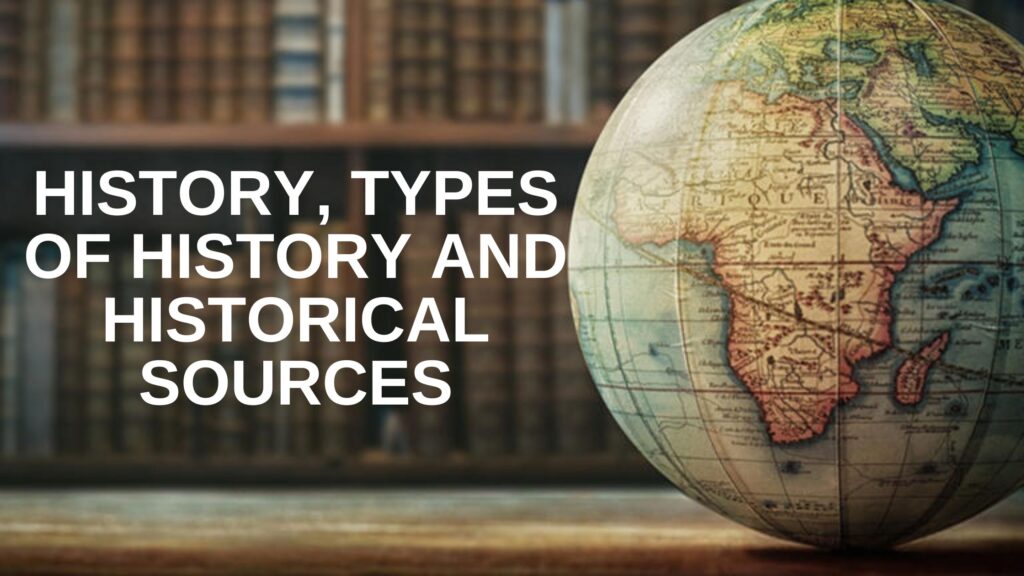The word history originates from the ancient Greek term Historia, which means “an inquiry.” History is the knowledge acquired by investigating past events, making it an exploration of the human past.
Types of History
History is categorized into six main types:
- Political History – Focuses on governance, power, and political events.
- Diplomatic History – Examines international relations, treaties, conflicts, and diplomacy.
- Cultural History – Explores art, literature, music, religion, and traditions.
- Economic History – Studies trade routes, economic policies, and industrialization.
- Social History – Analyzes social interactions, class dynamics, and cultural practices.
- Intellectual History – Investigates the evolution of ideas, philosophical developments, scientific advancements, and intellectual movements.

Classification of Historical Timelines
Historians categorize history based on technological progress, writing systems, and communication methods into three major phases:
Pre-history (Before Writing Systems)
- Paleolithic Age (Old Stone Age) (2,500,000 MYA – 11,700 years ago)
- Use of unpolished and rough stone tools.
- Evolution from proto-humans to modern humans.
- Mesolithic Age (Middle Stone Age) (11,700 years ago – 6000 BCE)
- Use of microlithic tools.
- Beginning of domestication and early cultivation.
- Neolithic Age (New Stone Age) (6000 BCE – 1000 BCE)
- Start of agriculture and permanent settlements.
- Use of polished stone tools and microlithic blades.
- Chalcolithic Age (Stone-Copper Age) (3000 BCE)
- Introduction of metal tools (copper and stone).
- Advanced cultivation and domestication.
Read more: Class 10 CBSE Admit Card 2025
Proto-history (Before Writing but Mentioned by Literate Cultures)
- Civilizations existed before the development of writing.
- Example: The Indus Valley Civilization (IVC) is considered proto-historical as its script remains undeciphered, but references exist in Mesopotamian texts.
History (After Writing Systems)
- Events recorded in written texts and archaeological sources.
- Example: The Edicts of Ashoka provide insights into Mauryan society, religion, and politics.
Classification of Historical Periods
- Ancient History – Before the invention of paper. Sources include inscriptions on rocks, metal plates, and palm leaves.
- Medieval History (500 AD – 1500 AD) – Introduction of paper, leading to extensive text records, including tax records, chronicles, and judicial accounts.
- Modern History (Post-1500 AD) – Begins with the decline of medieval structures, including colonial and industrial developments.
- Contemporary History (Post-1947) – Covers the post-independence era and major global events like the World Wars.
Sources of Indian History
Historical sources are classified based on their originality and the type of evidence they provide.
1. Based on Originality
- Primary Sources – First-hand records like Harappan seals and Kushan coins.
- Secondary Sources – Derived from primary sources, such as historical books and chronicles.
2. Based on Type of Evidence
A. Literary Sources (Written records)
- Indigenous Sources (Indian-origin documents)
- Secular – Non-religious works (e.g., Arthashastra by Kautilya).
- Non-Secular – Religious texts (e.g., Tipitaka of Buddhism).
- Foreign Sources (Records from external observers)
- Travelers – Hiuen Tsang recorded Harshavardhana’s reign.
- Diplomats – Megasthenes described Mauryan society.
- Geographers – Ptolemy documented Indian geography.
B. Archaeological Sources (Material evidence)
- Indigenous (Found within India)
- Pottery – Painted Grey Ware (PGW) of the Later Vedic Age.
- Inscriptions – Ashokan pillars.
- Coins & Seals – Kushan coins indicate Krishna worship.
- Monuments – Nalanda ruins highlight ancient education.
- Foreign (Found outside India)
- Boghaz-Koi inscription in Turkey mentions Vedic culture.
C. Paleontological Sources
- Study of fossils (e.g., Narmada Man skull discovery by Arun Sonakia).
D. Linguistic Theories
- Analysis of ancient languages to understand human migration.
- India has four major language families:
- Indo-European (Hindi, Assamese, Gujarati)
- Tibeto-Burman (Garo, Lepcha)
- Dravidian (Tamil, Telugu, Kannada)
- Austro-Asiatic (Munda, Santali)
E. Biological Studies (Genetics & DNA Research)
- Genetic studies reveal migration patterns:
- Negrito (65,000 years ago) – Andaman tribes.
- Proto-Australoid (9000–5000 years ago) – Indus Valley Civilisation.
- Mediterranid (Southwest Asia) – Early Harappans.
- Brachycephal (Western origin) – Parsis, Banias.
- Nordic Aryans (2000–1500 BCE) – Present in Punjab, Haryana.
- Mongoloids (China-origin) – Present in Northeast India.
Read more: SSC GD Admit Card 2025 Released
Conclusion
History is more than a collection of past events—it is an inquiry into human civilization, culture, governance, and evolution. Through various sources—literary, archaeological, biological, and linguistic—historians reconstruct the past to better understand human progress and societal transformations.
| Topic | Description |
|---|---|
| Stone Age | Evolution of early human civilization |
| Copper Age | Introduction of metallurgy |
| Harappan Civilisation | First urban civilization in India |
| Vedic Culture | The foundation of Hindu traditions |
| Mauryan Empire | First pan-Indian empire |
| Gupta Empire | Golden Age of India |


